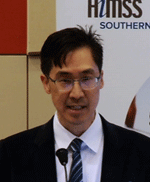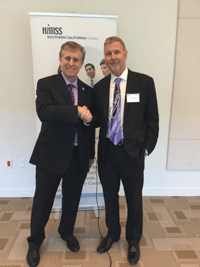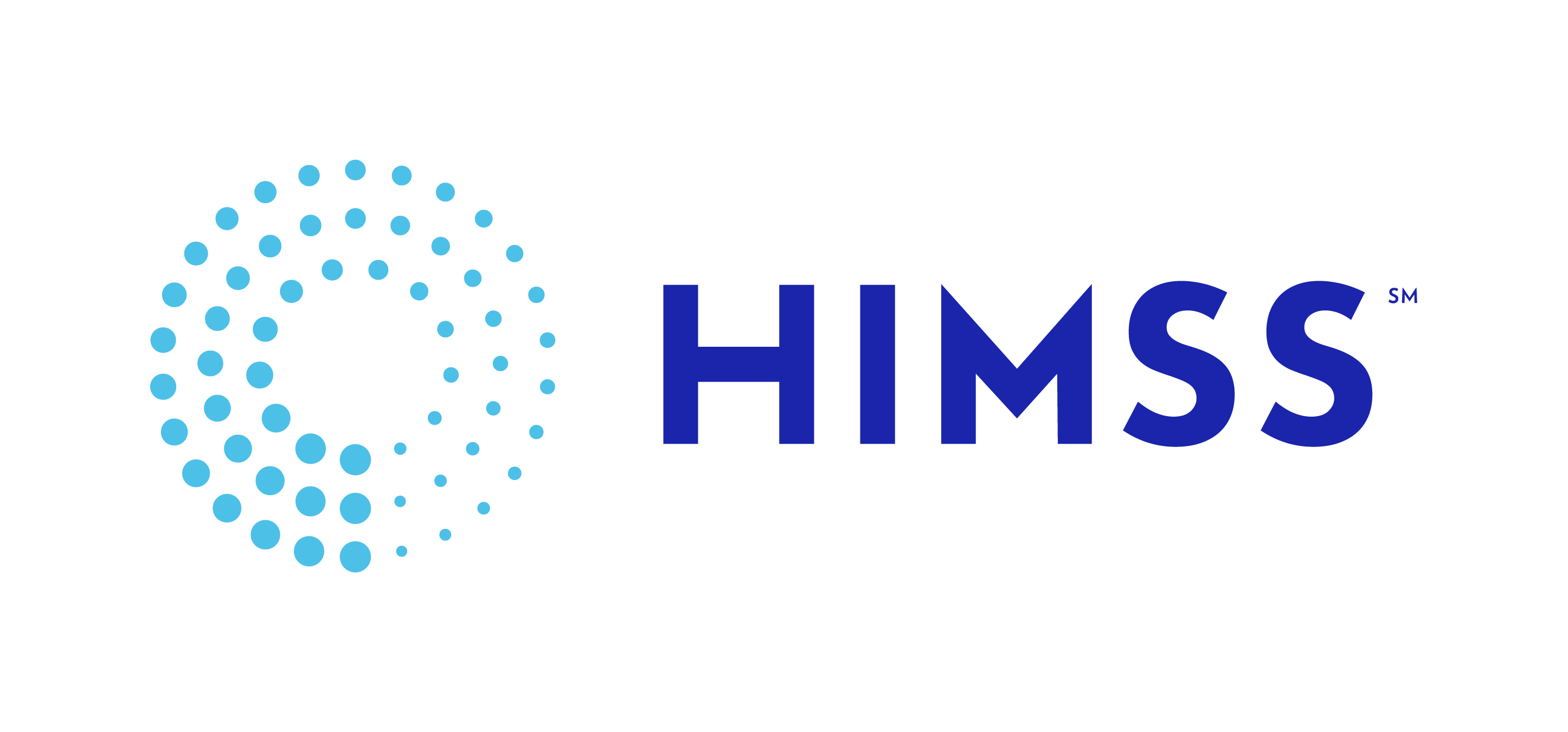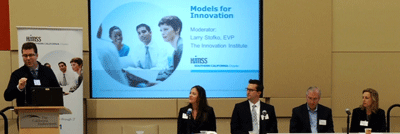Spring 2015HIMSS SoCal’s 5th Annual Healthcare IT Conference and Innovation Lab
by Karen J. Keating, PMP, CPHIMS, Roving Reporter , Co-chairperson, Marketing and Communications
The California Endowment…. Just East of Downtown Los Angeles, neighboring Olvera Street, Chinatown and Union Station, a light, modern structure houses a private health foundation dedicated to expanding access to affordable, quality healthcare.
Their slogan ‘Health Happens Here’ challenges us to think about health beyond the doctor's office. Our health happens where we live, learn, work and play.
State of the Chapter
Chapter President Jim Brady greeted 250 attendees to the largest-ever HIMSS SoCal HIT conference. After citing recent accomplishments, he announced upcoming events -- the 7th Annual Clinical Informatics Conference on May 15th in Irvine and the Career Roundtable on May 11th at UCLA. The Academic Alliance Community (AAC) event will focus on developing future HIT leaders, and providing students with training opportunities and scholarships.
Watch for upcoming correspondence encouraging Organizational Affiliate (OA) memberships. This employee benefit offers access to broad professional expertise, informative events and truly innovative ideas. An OA membership extends the impact of HIMSS SoCal across our region.
Keynote #1 – Healthcare Innovation: Reaching Across the Spectrum of Consumers
 Dr. David Rhew, CMO and VP of Global Healthcare at Samsung, showed a video on The Future of Human Healthcare and spoke on the expected convergence of medical and personal data, which he considers inevitable as devices, wearables, smart phones and apps proliferate. (Insert Link to photo)
Dr. David Rhew, CMO and VP of Global Healthcare at Samsung, showed a video on The Future of Human Healthcare and spoke on the expected convergence of medical and personal data, which he considers inevitable as devices, wearables, smart phones and apps proliferate. (Insert Link to photo)
Healthcare costs and funding remain an economic issue and healthcare is becoming inversely related to education. According to the California Department of Finance and national trends, funding for healthcare often occurs at the expense of education. Aging boomers and an increasingly complex world demand educated citizens, making this tradeoff ill-advised and unsustainable. It drives home the imperative to reduce healthcare costs, which are at 18% of the US GDP. An estimated 5% of patients consume 49% of resources and must be carefully managed. Who is your 5% today? Who will it be tomorrow?
Patients and their families have tremendous influence on the personal choices that prevent illness. They provide much needed social support. These two important factors can positively impact outcomes and costs. Engaging patients, using behavioral science techniques and consumer-based technology can promote better health. Sensor technology such as wearables, smartphone and tablet apps and future car sensors can inform patients and providers of conditions that need attention before they become serious.
How to get patients engaged? A study by the Mayo Clinic’s Cardiac Rehab Program discovered coaching opportunities on topics such as lifestyle, human biology and managing personal environments. Coaching patients builds awareness and develops communication channels, which positively impact health decisions. Patients at UCLA take surveys while waiting and responses are fed into the EMR, which provides context for clinicians. A Patient Activation Measure (PAM) score of 3-4 is correlated with better care coordination and fewer readmissions.
Communication is a vital element of population health management, especially when combined with Education and Engagement strategies. Ongoing communication fosters successful interventions. Establishing patient engagement requires that new habits to be formed, which requires motivation. Behavioral science offers methods to engage and sustain communication, using tools such as portals, social media, smartphone reminders and alerts. Proactive messaging can be effective for education and ensuring compliance at home – Did you take your meds? Have you seen your PCP a follow-up appointment? How are you feeling? Raw data motivates some, yet others need it to be interpreted to make it meaningful.
Managing population health and lowering costs requires a shift in focus from the acute setting to ambulatory and home-based care, employing technology. Panel members predict that tele-health and home-based care will become the norm as practices adapt their business models and use interactive tools and devices to cultivate personal contact and accountability. An example is to send alerts to patient and provider when there is a downward health trend. This can trigger a timely, personalized intervention before an acute episode strikes.
Predictive analytics can also be used to develop a customized and relevant patient experience. To date, personalized medicine has involved genetic testing, diagnosis and treatment. Yet this is beyond the reach of most consumers. Managing illness with technology-enabled engagement can personalize medicine for the masses.
Models for Innovation
- The UCLA Institute for Innovation in Health is focused on identifying practices that transform the care process. Physicians are involved in and work on projects. Selected technologies are piloted before they are broadly deployed and scaled across the enterprise. These efforts support UCLA’s overarching strategy.
- At the Cleveland Clinics, innovation is focused on translating emerging technologies into therapeutics by incubating and de-risking solutions before they are commercialized. At Cleveland Clinics, physicians work through dedicated communication channels to solicit ideas from their practices.
- Summation Health Ventures is a partnership of two health systems - Cedars Sinai Health System and Memorial Healthcare to provide strategic investment funding focused on innovative technology that improves care, enhances the patient and clinician experience, decreases costs and improves outcomes.
- The UCI Technology Transfer Office is building an entrepreneurial ecosystem that brings new technologies to market to benefit the public. To date, 950 inventions have been realized. UCI holds seminars for clinicians to present problems and solutions. This spring ‘The Cove’ will be launched to provide expertise, advice, coaching and funding for budding entrepreneurs.
The Evolution of Business Intelligence
(Slides)
 Chuck Podesta, CIO at UC Irvine Medical Center, talked about new tools that are changing the game. The old model, moving relational data to Excel, adding graphics and dashboards for visualization, has evolved to a new model, where centralized data warehouses (CDW) relies on Hadoop, Tableau and Portals. Query results are mapped to metadata for external analysis and findings are brought back to the point of care for closed loop analytics.
Chuck Podesta, CIO at UC Irvine Medical Center, talked about new tools that are changing the game. The old model, moving relational data to Excel, adding graphics and dashboards for visualization, has evolved to a new model, where centralized data warehouses (CDW) relies on Hadoop, Tableau and Portals. Query results are mapped to metadata for external analysis and findings are brought back to the point of care for closed loop analytics.
- Dexcom continuous glucose monitors are a 4th generation, FDA-approved biosensor that acquires data from a wire placed beneath the skin. It provides 25 glucose results/day compared to 4-5/day with current methods. Plans call for integration and alerts with mobile devices via Bluetooth.
- Qualcomm Life is focused on using patches to detect biometric information. Bluetooth can detect and transmit biometric data. Asynchronous messaging can exchange images on portable devices. By 2020, an estimated 25 billion smart phones will support Mobile (M) Health.
 Scott Weingarten MD, Cedars-Sinai Health System, talked about what follows the EHR Go Live. Cedars activated 120 clinical alerts 18 months ago. This strategic decision required careful preparation, communication and effort to gain medical staff approval. Dr. Weingarten shared that physician discussions were 98% about culture, quality and workflow and 2% about "how". To date, a $4M / year savings has been realized. Here are several lessons learned:
Scott Weingarten MD, Cedars-Sinai Health System, talked about what follows the EHR Go Live. Cedars activated 120 clinical alerts 18 months ago. This strategic decision required careful preparation, communication and effort to gain medical staff approval. Dr. Weingarten shared that physician discussions were 98% about culture, quality and workflow and 2% about "how". To date, a $4M / year savings has been realized. Here are several lessons learned:
- Advise physicians and let them retain autonomy. They want to contribute to solving problems.
- Cedars is still on the journey from the "soft stop" (no clicks) to a ‘medium stop’ (user input).
- Clinical decision support (CDS) is 112 times more likely to improve the quality and cost of care.
- Workflow Best Practices are innovation. Clinicians know their workflow and technology has to adapt.
According to Dr. Weingarten, “There has never been a better time to be an Innovator in Healthcare.”
Driving Innovation in Healthcare
(Slides)
James Brady, PhD, FHIMSS, reviewed the leading edge efforts underway at Kaiser Permanente to advance care in the era of technology. Total health is a worldwide mega trend. Developing interoperability and enabling Mobile Health is a significant challenge. Applying technology to extend care and manage costs is what today’s health care leaders must do.
With such a wealth of experience to be shared, the room was still full when the meeting ended. We hope can join us next time! Until then, we invite you to catch up on the sessions through our YouTube channel.

 Slides
Slides